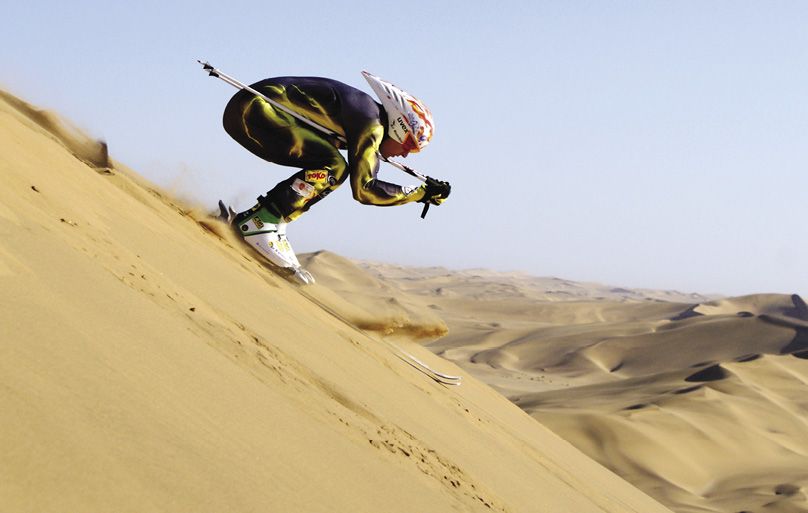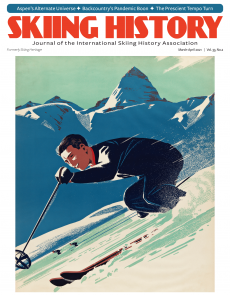SKIING HISTORY
Editor Greg Ditrinco
Consulting Editor Seth Masia
Art Director Edna Baker
Editorial Board
Seth Masia, Chairman
John Allen, Andy Bigford, John Caldwell, Jeremy Davis, Kirby Gilbert, Paul Hooge, Jeff Leich, Bob Soden, Ingrid Wicken
Founding Editors
Morten Lund, Glenn Parkinson
To preserve skiing history and to increase awareness of the sport’s heritage
ISHA Founder
Mason Beekley, 1927–2001
ISHA Board of Directors
Chan Morgan, Chairman
Seth Masia, President
Wini Jones, Vice President
Jeff Blumenfeld, Vice President
John McMurtry, Vice President
Chan Morgan, Treasurer
Einar Sunde, Secretary
Richard Allen, Skip Beitzel, Michael Calderone, Art Currier, Dick Cutler, Chris Diamond, David Ingemie, Joe Jay Jalbert, Rick Moulton, Wilbur Rice, Charles Sanders, Bob Soden (Canada)
Presidential Circle
Christin Cooper, Billy Kidd, Jean-Claude Killy, Bode Miller, Doug Pfeiffer, Penny Pitou, Nancy Greene Raine
Business & Events Manager
Kathe Dillmann
P.O. Box 1064
Manchester Center VT 05255
(802) 362-1667
kathe@skiinghistory.org
Membership Services
Laurie Glover
(802) 375-1105
laurie@skiinghistory.org
Corporate Sponsorships
Peter Kirkpatrick
(541) 944-3095
peterk10950@gmail.com
Bimonthly journal and official publication of the International Skiing History Association (ISHA)
Partners: U.S. Ski and Snowboard Hall of Fame | Canadian Ski Museum and Hall of Fame
Alf Engen Ski Museum | North American Snowsports Journalists Association | Swiss Academic Ski Club
Skiing History (USPS No. 16-201, ISSN: 23293659) is published bimonthly by the International Skiing History Association, P.O. Box 1064, Manchester Center, VT 05255.
Periodicals postage paid at Manchester Center, VT and at additional mailing offices. Postmaster: Send address changes to ISHA, P.O. Box 1064, Manchester Center, VT 05255
ISHA is a 501(c)(3) public charity. EIN: 06-1347398
Written permission from the editor is required to reproduce, in any manner, the contents of Skiing History, either in full or in part.
Skiers Will Ski on Anything -- Especially Sand
Lack of snow deters not the true believer.
Photo above: German sand-skiing speed record holder (nearly 60 mph) Henrik May shows his form on the sands of Namibia.
Snow is unquestionably top of the heap for sliding. Not to get all Poindexter on you, but skis slide easily thanks to a very thin layer of meltwater between the skis and the snow.
So what happens if it doesn’t snow? Or what if it’s one of those three warmer seasons that shall remain nameless? That’s where history has proven skiers will ski on just about anything, especially sand.
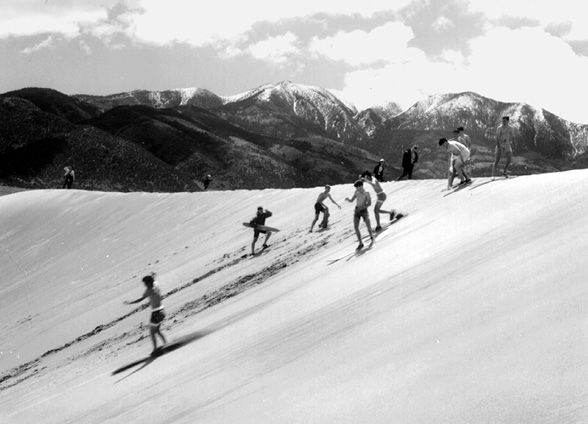
America, the Great Sand Dunes
preserve has been the hub of U.S. sand
skiing for decades. National Park
Service photo.
For decades, the mecca for sand skiing in the U.S. has been the Great Sand Dunes National Park and Preserve near Alamosa, Colorado, North America’s tallest dunes. Opened in 1932 as a national monument, it became a national park in 2004.
Each fall, ski bums return to Great Sand Dunes to ski or board 34-degree, 742-foot-high dunes in a tradition that, for many, begins the new ski season. One enthusiast tells OutThereColorado.com, “Sand is not as slippery as snow, so it’s like skiing in slow motion. You have to make shallow turns, but it’s definitely real skiing. That’s why we come back every year—because we’re jonesin’ to ski.”
The Great Dunes skier was accurate, if not precise, about the relative slickness of sand vs. snow. To get technical (stay with me here): dry sand has a dynamic coefficient of friction of about .55 compared to snow at about .03—depending on the snow and the ski wax. So sand is about 18 times more resistant to gliding than snow. But if you dampen the sand a bit (just a bit) the coefficient can go down to a range of .3 to .45, depending on the size of the sand grains and how wet the conditions are. Ancient pyramid-builders poured water on desert sand to more easily drag massive sleds. And that’s why savvy sand skiers hit the Great Dunes slopes after a rain.
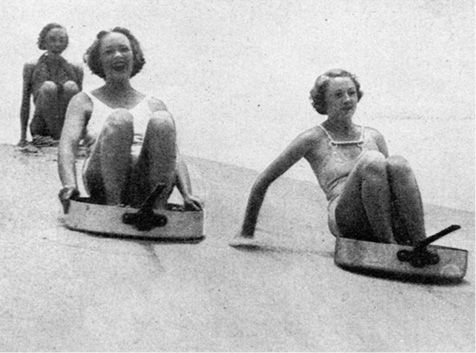
National Monument in 1932, and visitors
grabbed whatever was at hand to start
sliding. Cooking pots were fast enough.
NPS photo.
At the Great Dunes, sandboards can be rented outside the park and are more popular than skis. It seems that while sand doesn’t appear to damage the base of alpine skis, it may dull edges and jam bindings. Sandboard bases, much harder than snowboard bases, are usually treated with paraffin-based wax to reduce friction, and it works like a charm on rain-soaked sand.
Sand skiing in the Colorado desert is not without risk. Great Dunes sand can reach 150 degrees F., lightning can occur at any time during the warmer months, and in high winds, those Covid masks come in handy. Eye protection, long sleeves and pants are helpful to avoid getting sandblasted.
Still, sand is better than other sliding surfaces known to lure skiers.
Members of the Facebook group Elite Skiing report sliding on volcanic ash, pine needles, scree (loose stones), shale, coal slag, carpet, soap flakes, powdered mica, and even gravel and barite mixed with used motor oil. During the heyday of the New York State Borscht Belt in the Catskills, Grossinger’s resort hotel experimented with ground-up collar buttons (see Skiing History, May/June 2020).
For millions of snow-starved Europeans, there’s one word: plastics. So-called dry slopes are part of a cottage industry tracked by Dry Slope News, established in 2018. “People have been skiing on slopes without snow for over a century, but the earliest artificial surfaces manufactured especially for skiing date from the 1950s,” says editor Patrick Thorne.
“Since the first few dry slopes appeared, close to 2,000 have been built in more than 50 countries worldwide. At the height of dry skiing’s popularity in the early 1980s, there were reports of over 300 in Great Britain alone.”
Sand Skiing Gets its Start in Africa
Some 44 countries offer sandboarding today according to Sandboard.com.
Modern sand skiing dates back to 1927 when French athlete, mountaineer, aviator, and journalist Marie Marvingt (1875-1963) combined her careers as a surgical nurse and military aviator, to create aluminum skis for an experimental medevac airplane to land on Saharan sand in Morocco and Algeria (see Skiing History, March-April 2020).
By then a decorated hero of World War I and credited as the world’s first female combat pilot, Marvingt hired a metal shop in her home town of Nancy to forge personal skis from solid aircraft-grade aluminum alloy. She determined metal sand skis were better than wood and certainly better than walking up dunes in sandals, reportedly testing them on sand for 50 miles. One year later, she started a ski school for Berbers, along the snowless Moroccan coast.
Marvingt’s legacy continues in the northern African country. Today, people who engage in guided ski touring on the snows of Mount Toubkal or take advantage of the lift service at Oukaimeden in the rugged High Atlas Mountains in southwestern Morocco, also head a few hours southeast to the edge of the Sahara Desert to sand ski or sandboard for bragging rights.
Four thousand miles farther south, in Namibia, the German-born Henrik May, 45, has been pioneering the sport of sand skiing for two decades, according to Powder magazine (July 2013). There, the Namib Desert is home to some of the largest dunes in the world, thousands of miles from the nearest snow.
May’s company, Ski Namibia (ski-namibia.com), is one of the very few dune ski-specific operations in the world and has been featured by NBC’s Today Show and the CBS reality show, The Amazing Race. He started his touring company in 2003 and since then has logged thousands of ski descents. He set a Guinness world speed record in 2010, reaching 92.12 km/h (57.24 mph) on sand. He introduced Wustenskisport, or dune skiing, to the internet with guided runs usually between 200 to 400 vertical feet after climbs of around 20 minutes.
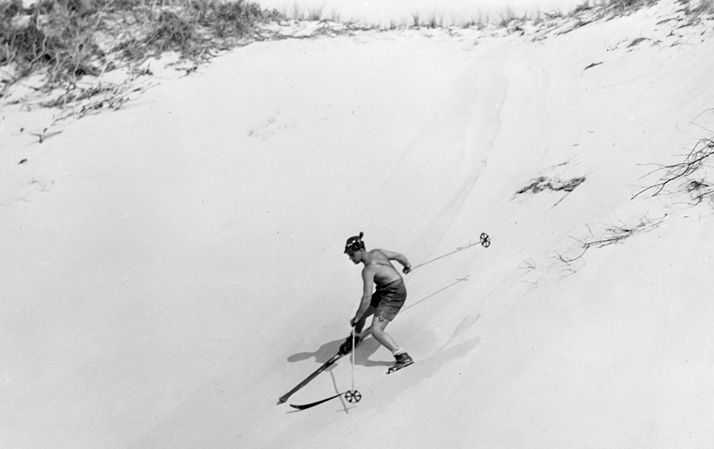
Sand & Pine Needle Ski School, flashes
a wedge turn in 1937. Christine Reid,
New England Ski Museum.
Back in the U.S.A.
Sand skiing in the United States dates back at least to 1937 on the Cape Cod, Massachusetts, side of Nantucket Sound. According to the New York Times (Sept. 12, 1937), “Some of the dunes near Centerville are unusually long, permitting runs of 100 and 150 feet, on which a skier can attain speeds of about forty miles an hour. . . Wooden skis slide easily on the sand and gain speed, particularly when the sand is covered by short grass or pine needles.”
At any rate, those Centerville dunes are long gone, according to Patti Machado, town of Barnstable Director of Recreation in Hyannis, Massachusetts. “We do not have any dunes. I think that the beach topography may have been different back then,” she emails Skiing History.
One famed sand skiing competition was Sandblast in Prince George, British Columbia, held every August from 1971 to 2003. It attracted thousands of spectators to a dual slalom race among so-called “sandblasters” who didn’t want summer to get in the way of their favorite sport. Just north of the city by the Nechako River is a steep hill called the Cutbanks where 10 to 15-sec. races were once held on a 500-foot slope of sand and gravel. It was popular over the decades and people traveled long distances to participate, including filmmaker Warren Miller, according to FreeThoughtBlogs.com.
Amazingly, no one was ever seriously injured. But according to the TV show BC Was Awesome, hosted by Bob Kronbauer, in 2003 some yahoos descended in a three-wheeled couch. The resulting crash scared off the insurance companies, leading to a permanent ban.
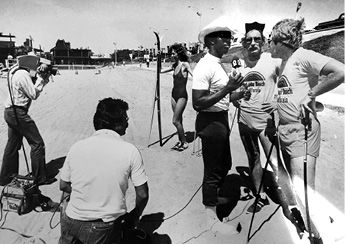
Redondo Beach, California, attracted
media, which trumpeted "sand skiing
is sweeping the country. Peter Graves.
Sand and Deliver
Sand skiing was also popular as a cross-country competition on Pacific Ocean beaches during that era. In 1980, Bjorn Arvnes of Norway, winner of the 1977 American Birkebeiner, won the sand XC skiing title at the Epoke Beach Classic at Redondo Beach, California. Event producers were Larry Harrison, a rep for NorTur, the U.S. importer of Epoke Skis, and Peter Graves, NorTur marketing director.
The sand skiing stunt appeared on NBC’s Real People, page one of the Los Angeles Times, and even in the National Enquirer, which wrote breathlessly that “sand skiing was sweeping the country.” Tom Kelly, who handled event promotion with Graves, tells Skiing History, “It was a hugely successful media event for the time, garnering national coverage for Epoke.”
Other favorite North American sand skiing locations are Jockey’s Ridge State Park in North Carolina, White Sands National Park in New Mexico, Idaho’s Bruneau Sand Dunes and St. Anthony Sand Dunes, California’s San Bernardino Mountains, and Sandbanks Provincial Park in Ontario.
In the end, sand has an enduring advantage over snow: It doesn’t melt. 
ISHA VP Jeff Blumenfeld’s most recent contribution to Skiing History was “The Day They Threw Cow Chips in Las Vegas” (January-February 2021).
Table of Contents

Corporate Sponsors
ISHA deeply appreciates your generous support!
WORLD CHAMPIONSHIP ($3,000 AND UP)
Gorsuch
Polartec
WORLD CUP ($1,000)
Aspen Skiing Company
BEWI Productions
Bogner
Boyne Resorts
Dale of Norway
Darn Tough Vermont
Dynastar | Lange | Look
Fairbank Group: Bromley, Cranmore, Jiminy Peak
Gordini USA Inc. | Kombi LTD
HEAD Wintersports
Hickory & Tweed Ski Shop
Intuition Sports, Inc.
Mammoth Mountain
Marker-Volkl USA
Outdoor Retailer
Rossignol
Ski Area Management
Ski Country Sports
Snowsports Merchandising Corporation
Sport Obermeyer
Sports Specialists, Ltd.
Sun Valley Resort
Vintage Ski World
Warren and Laurie Miller
World Cup Supply, Inc.
GOLD ($700)
Race Place | BEAST Tuning Tools
The Ski Company (Rochester, NY)
Thule
SILVER ($500)
Alta Ski Area
Boden Architecture PLLC
Dalbello Sports
Ecosign Mountain Resort Planners
Fera International
Holiday Valley
Hotronic USA, Inc. | Wintersteiger
MasterFit Enterprises
McWhorter Driscoll, LLC
Metropolitan New York Ski Council
New Jersey Ski & Snowboard Council
NILS, Inc.
Russell Mace Vacation Homes
Schoeller Textile USA
Scott Sports
Seirus Innovations
SeniorsSkiing.com
Ski Utah
Swiss Academic Ski Club
Tecnica Group USA
Trapp Family Lodge
Western Winter Sports Reps Association
World Pro Ski Tour

